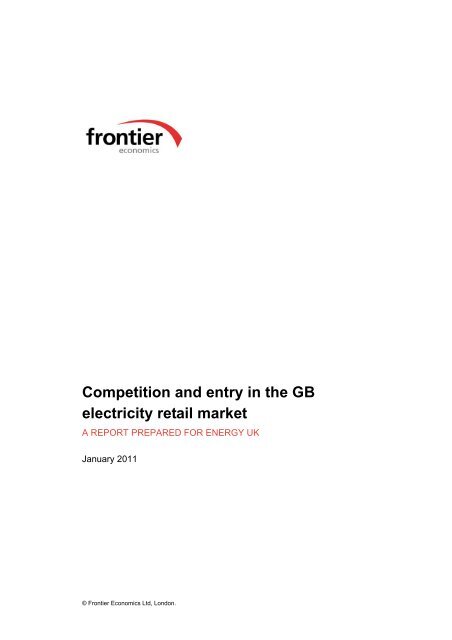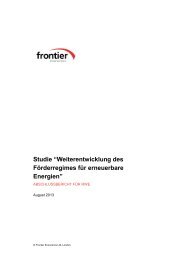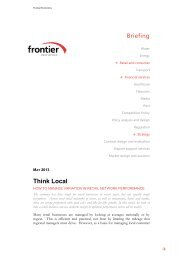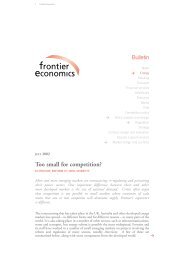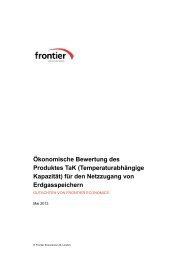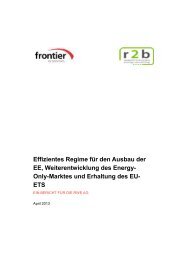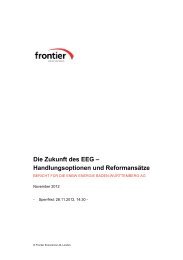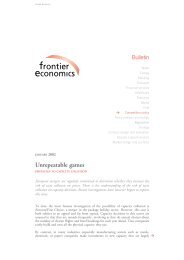competition and entry in the gb electricity retail market.pdf - Frontier ...
competition and entry in the gb electricity retail market.pdf - Frontier ...
competition and entry in the gb electricity retail market.pdf - Frontier ...
You also want an ePaper? Increase the reach of your titles
YUMPU automatically turns print PDFs into web optimized ePapers that Google loves.
Competition <strong>and</strong> <strong>entry</strong> <strong>in</strong> <strong>the</strong> GB<br />
<strong>electricity</strong> <strong>retail</strong> <strong>market</strong><br />
A REPORT PREPARED FOR ENERGY UK<br />
January 2011<br />
© <strong>Frontier</strong> Economics Ltd, London.
January 2011 | <strong>Frontier</strong> Economics i<br />
Competition <strong>and</strong> <strong>entry</strong> <strong>in</strong> <strong>the</strong> GB<br />
<strong>electricity</strong> <strong>retail</strong> <strong>market</strong><br />
Executive Summary 1<br />
1 How competitive is <strong>the</strong> <strong>market</strong>? 5<br />
1.1 Customer engagement .............................................................. 5<br />
1.2 Evolution of <strong>market</strong> structure ..................................................... 6<br />
1.3 Type of <strong>competition</strong>.................................................................... 9<br />
2 Barriers to <strong>entry</strong> 11<br />
2.1 Deliver<strong>in</strong>g Government policy .................................................. 11<br />
2.2 Access to wholesale energy supplies ...................................... 12<br />
2.3 Low marg<strong>in</strong>s............................................................................. 18<br />
2.4 Complexity <strong>and</strong> regulatory burden ........................................... 19<br />
2.5 Network charges ...................................................................... 19<br />
2.6 Scale economies...................................................................... 19<br />
3 Options for change 21<br />
3.1 Reduce regulatory burden........................................................ 21<br />
3.2 Liquidity.................................................................................... 23<br />
3.3 Credit risk................................................................................. 25<br />
3.4 Cash-out arrangements ........................................................... 26<br />
3.5 Increase network charge stability............................................. 27<br />
3.6 Deliver on potential of smart meter roll-out .............................. 27<br />
Contents
ii <strong>Frontier</strong> Economics | January 2011<br />
Competition <strong>and</strong> <strong>entry</strong> <strong>in</strong> <strong>the</strong> GB<br />
<strong>electricity</strong> <strong>retail</strong> <strong>market</strong><br />
Figure 1. Comparative aggregate churn rates 14<br />
Figure 2. Longer dated GB liquidity 15<br />
Figure 3. Proportion of GB OTC trad<strong>in</strong>g by period of delivery 16<br />
Table 1. Retail Market Position <strong>in</strong> Electricity, 2008. 7<br />
Tables & Figures
Executive Summary<br />
January 2011 | <strong>Frontier</strong> Economics 1<br />
The <strong>electricity</strong> <strong>retail</strong> <strong>market</strong> was liberalised over ten years ago. Interest<br />
<strong>in</strong> this <strong>market</strong> has <strong>in</strong>creased over <strong>the</strong> last few years, with some<br />
suggest<strong>in</strong>g that <strong>competition</strong> is not fully effective. We were asked to<br />
provide an <strong>in</strong>dependent view about <strong>the</strong> level of <strong>competition</strong> <strong>in</strong> this<br />
<strong>market</strong>, <strong>and</strong> provide options that could be taken to promote fur<strong>the</strong>r<br />
<strong>entry</strong>. We believe that <strong>the</strong> <strong>market</strong> is competitive. However, as we would<br />
expect <strong>in</strong> a <strong>market</strong> that is characterised by high risk, a large capital<br />
requirement <strong>and</strong> substantial Government <strong>and</strong> regulatory <strong>in</strong>tervention,<br />
some barriers to <strong>entry</strong> rema<strong>in</strong>. Although <strong>the</strong>re are actions that could<br />
<strong>in</strong>crease <strong>entry</strong>, <strong>the</strong>y often distort <strong>the</strong> <strong>market</strong> <strong>and</strong> have an associated<br />
cost. Policy makers <strong>the</strong>refore need to be sure that <strong>the</strong> benefit from new<br />
<strong>entry</strong> can reasonably be expected to exceed all costs that may come<br />
with its promotion.<br />
Both Government <strong>and</strong> Ofgem have completed detailed <strong>in</strong>vestigations<br />
of <strong>the</strong> <strong>electricity</strong> <strong>retail</strong> <strong>market</strong> <strong>in</strong> recent years. Nei<strong>the</strong>r found any<br />
evidence of collusion <strong>in</strong> <strong>the</strong> <strong>market</strong>. Fur<strong>the</strong>r, <strong>the</strong> returns <strong>the</strong> companies<br />
were mak<strong>in</strong>g were often low <strong>and</strong> sometimes negative. Competition <strong>in</strong><br />
this sector, both by number of suppliers <strong>and</strong> customer switch<strong>in</strong>g rates,<br />
also compares favourably with <strong>the</strong> rest of Europe. However, although<br />
<strong>the</strong>re has been new <strong>entry</strong>, barriers prevent<strong>in</strong>g new suppliers enter<strong>in</strong>g<br />
<strong>and</strong> exp<strong>and</strong><strong>in</strong>g were identified by Government <strong>and</strong> Ofgem. In addition,<br />
Ofgem is currently undertak<strong>in</strong>g a fur<strong>the</strong>r review of <strong>the</strong> <strong>market</strong> 1 .<br />
Any assessment of this <strong>market</strong> must be seen <strong>in</strong> <strong>the</strong> context of <strong>the</strong><br />
change that <strong>the</strong> energy sector is undergo<strong>in</strong>g. An estimated £200bn of<br />
<strong>in</strong>vestment is needed to deliver <strong>the</strong> dual challenge of decarbonisation<br />
<strong>and</strong> deliver<strong>in</strong>g security of supply over <strong>the</strong> next 10 to 15 years 2 . To<br />
underst<strong>and</strong> <strong>the</strong> future of <strong>competition</strong> <strong>in</strong> this <strong>market</strong>, we need to<br />
underst<strong>and</strong> what we expect suppliers’ role to be <strong>in</strong> deliver<strong>in</strong>g this<br />
vision. If Government wishes to use suppliers to deliver policy, it needs<br />
to recognise that <strong>entry</strong> <strong>in</strong>to this <strong>market</strong> may well become harder.<br />
Our view is that price <strong>competition</strong> <strong>in</strong> this <strong>market</strong> is strong <strong>and</strong> we have<br />
seen no evidence that it is fail<strong>in</strong>g to deliver <strong>the</strong> efficient provision of<br />
<strong>retail</strong> services to customers. Suppliers have also been active <strong>in</strong><br />
deliver<strong>in</strong>g <strong>in</strong>novation. However, it is important that <strong>the</strong> pressure to<br />
1 “Ofgem to review <strong>the</strong> effectiveness of <strong>the</strong> <strong>retail</strong> energy <strong>market</strong> to see if fur<strong>the</strong>r action is needed to<br />
protect consumers”, Ofgem (26 November 2010).<br />
2 Speech by Charles Hendry to <strong>the</strong> Fuellers lecture 25 th Anniversary (20 September 2010).<br />
Executive Summary
2 <strong>Frontier</strong> Economics | January 2011<br />
<strong>in</strong>novate rema<strong>in</strong>s strong, particularly follow<strong>in</strong>g <strong>the</strong> imm<strong>in</strong>ent roll-out of<br />
smart meters <strong>and</strong> <strong>the</strong> <strong>in</strong>creased opportunities that this could br<strong>in</strong>g.<br />
As expected <strong>in</strong> a <strong>market</strong> with <strong>the</strong> characteristics of <strong>electricity</strong> <strong>retail</strong>,<br />
<strong>the</strong>re are barriers to <strong>entry</strong> particularly for smaller suppliers. Fur<strong>the</strong>r,<br />
<strong>the</strong>re are not many “easy w<strong>in</strong>s” <strong>in</strong> terms of lower<strong>in</strong>g <strong>the</strong>se barriers.<br />
Instead <strong>the</strong>re will be an associated cost connected with reduc<strong>in</strong>g <strong>the</strong>m.<br />
Clearly any policy change that comes with a cost should be pursued<br />
only if <strong>the</strong>re is sufficient certa<strong>in</strong>ty that it will deliver a more than<br />
compensatory benefit. Policy makers should <strong>the</strong>refore be sure that<br />
<strong>the</strong>re is a sufficient case for sacrific<strong>in</strong>g some static efficiency to<br />
<strong>in</strong>crease <strong>entry</strong> on <strong>the</strong> basis that this will deliver more dynamic<br />
efficiency <strong>in</strong> future.<br />
In our view, <strong>the</strong> ma<strong>in</strong> barriers, <strong>and</strong> options to reduce <strong>the</strong>m, <strong>in</strong>clude <strong>the</strong><br />
follow<strong>in</strong>g.<br />
• Deal<strong>in</strong>g with Government policy <strong>and</strong> regulatory <strong>in</strong>tervention:<br />
Government has <strong>in</strong>creas<strong>in</strong>gly used suppliers to deliver policy, both<br />
to meet environmental objectives <strong>and</strong> social obligations. The<br />
number of policies, <strong>and</strong> <strong>the</strong>ir cost <strong>and</strong> complexity, has grown<br />
rapidly. These act as a barrier to <strong>entry</strong> <strong>and</strong> growth, particularly for<br />
smaller suppliers that reach <strong>the</strong> thresholds for participation.<br />
Fur<strong>the</strong>r, as <strong>the</strong>se requirements have <strong>in</strong>creased, <strong>the</strong> importance of<br />
<strong>competition</strong> seems to have been downgraded. There are an<br />
<strong>in</strong>creas<strong>in</strong>g number of regulations that essentially limit <strong>competition</strong><br />
between suppliers. One of <strong>the</strong> most commented-upon examples is<br />
<strong>the</strong> <strong>in</strong>troduction of <strong>the</strong> non-discrim<strong>in</strong>ation licence provisions <strong>in</strong><br />
2009. Ofgem should review <strong>the</strong> impact of <strong>the</strong>se regulations as part<br />
of its current <strong>retail</strong> <strong>market</strong> <strong>in</strong>vestigation given that <strong>the</strong>ir impact is<br />
likely to have weakened <strong>competition</strong>. Reform of this policy is not<br />
only an easy w<strong>in</strong>, but should also be a pre-requisite to any fur<strong>the</strong>r<br />
action to reduce o<strong>the</strong>r barriers to <strong>entry</strong> s<strong>in</strong>ce o<strong>the</strong>r options to<br />
promote <strong>competition</strong> are likely to come with higher risks <strong>and</strong> costs<br />
associated with <strong>the</strong>m.<br />
• Liquidity: The recent focus on liquidity be<strong>in</strong>g <strong>the</strong> biggest barrier to<br />
<strong>entry</strong> may have been over-played. However, it is <strong>the</strong> case that<br />
smaller suppliers have found less liquidity for tailored “shaped”<br />
products of a small clip size that match <strong>the</strong>ir <strong>retail</strong> portfolio. The<br />
recent evidence is that this may be chang<strong>in</strong>g: <strong>the</strong> products <strong>and</strong><br />
volumes available on exchanges are cont<strong>in</strong>u<strong>in</strong>g to <strong>in</strong>crease <strong>and</strong><br />
Executive Summary
January 2011 | <strong>Frontier</strong> Economics 3<br />
<strong>in</strong>dustry <strong>in</strong>itiatives to take positive steps to <strong>in</strong>crease liquidity have<br />
been announced 3 . As Ofgem also notes <strong>in</strong> its recent update on<br />
liquidity 4 , we believe <strong>the</strong>re is a clear benefit to giv<strong>in</strong>g <strong>the</strong>se positive<br />
<strong>in</strong>itiatives a chance to take hold before seek<strong>in</strong>g fur<strong>the</strong>r<br />
<strong>in</strong>terventions, given that any fur<strong>the</strong>r <strong>in</strong>terventions are not without<br />
costs <strong>and</strong> risks.<br />
• Credit risk: The requirements for collateral to cover credit risk are<br />
a problem for smaller, less well capitalised players that do not have<br />
a credit rat<strong>in</strong>g. This is difficult to resolve given that requir<strong>in</strong>g<br />
collateral <strong>in</strong> such circumstances is clearly appropriate, while any<br />
solution that <strong>in</strong>volves reduc<strong>in</strong>g or remov<strong>in</strong>g <strong>the</strong> cost of failure for<br />
<strong>in</strong>dividual participants would <strong>in</strong>troduce a problem of moral hazard<br />
<strong>and</strong> is <strong>the</strong>refore likely to come at too high a cost. Instead we would<br />
recommend wait<strong>in</strong>g to see if <strong>the</strong> measures to <strong>in</strong>crease liquidity also<br />
encourage a centralised clear<strong>in</strong>g entity to enter, as seen <strong>in</strong><br />
Germany <strong>and</strong> <strong>the</strong> Nordic region. This would allow collateral to be<br />
posted on net, ra<strong>the</strong>r than gross, positions.<br />
• Network charge stability: The frequent regulatory reviews of <strong>the</strong><br />
structure of charges have meant that <strong>the</strong>re has been an <strong>in</strong>crease <strong>in</strong><br />
variability of network charges, <strong>and</strong> a lack of transparency to<br />
suppliers about <strong>the</strong> direction <strong>and</strong> tim<strong>in</strong>g of changes to <strong>the</strong>m. Ofgem<br />
should take more account of <strong>the</strong> supplier implications of <strong>the</strong> policy<br />
changes it makes to network charges. In particular, it should seek<br />
to ensure that any result<strong>in</strong>g changes <strong>in</strong> charges are notified to<br />
suppliers sufficiently far <strong>in</strong> advance, <strong>and</strong> for charges to be kept<br />
stable for sufficiently long periods. Suppliers will <strong>the</strong>n f<strong>in</strong>d it easier<br />
to offer <strong>the</strong> price stability that most customers expect. This will<br />
become more important if, as expected, network charges start to<br />
rise.<br />
3 For example, see “ScottishPower’s six commitments to boost wholesale power <strong>market</strong> liquidity”,<br />
open letter to Ofgem (10 December 2010).<br />
4 “Liquidity <strong>in</strong> <strong>the</strong> GB power <strong>market</strong>: Update”, Ofgem (3 December 2010).<br />
Executive Summary
1 How competitive is <strong>the</strong> <strong>market</strong>?<br />
January 2011 | <strong>Frontier</strong> Economics 5<br />
In this section we provide a brief overview of <strong>the</strong> level, <strong>and</strong> type, of <strong>competition</strong><br />
<strong>in</strong> <strong>the</strong> energy <strong>retail</strong> sector. We assess its strengths <strong>and</strong> weaknesses <strong>and</strong> see where<br />
<strong>the</strong>re may be a case for fur<strong>the</strong>r <strong>in</strong>tervention.<br />
New <strong>entry</strong> to this <strong>market</strong> has been relatively low <strong>in</strong> recent years. However, this is<br />
nei<strong>the</strong>r necessarily surpris<strong>in</strong>g, nor necessarily detrimental to customers. Price<br />
<strong>competition</strong> <strong>in</strong> this <strong>market</strong> has been strong <strong>and</strong> suppliers have competed actively<br />
for <strong>market</strong> share. There have also been a number of <strong>in</strong>novations <strong>in</strong> energy <strong>retail</strong><br />
services.<br />
We look at <strong>competition</strong> <strong>in</strong> <strong>the</strong> <strong>market</strong> across <strong>the</strong> follow<strong>in</strong>g dimensions:<br />
customer engagement;<br />
evolution of <strong>market</strong> structure; <strong>and</strong><br />
type of <strong>competition</strong>.<br />
1.1 Customer engagement<br />
Customer engagement is a clear success story of energy liberalisation <strong>in</strong> <strong>the</strong> UK.<br />
By 2008, at least 75% of customers had switched energy supplier at least once.<br />
This is equivalent to just under 20 million households. 5 Fur<strong>the</strong>r, of those who<br />
have never switched, a sizeable majority (83%) are aware that it is possible to<br />
switch. 6 Ofgem concluded that:<br />
“The level of consumer participation <strong>in</strong> GB energy supply <strong>market</strong>s is amongst <strong>the</strong> highest of any<br />
<strong>retail</strong> energy <strong>market</strong> throughout <strong>the</strong> world. The annual switch<strong>in</strong>g rate of 18 per cent also<br />
compares well with o<strong>the</strong>r <strong>retail</strong> services <strong>in</strong> <strong>the</strong> UK, such as fixed <strong>and</strong> mobile telecommunication,<br />
<strong>in</strong>surance products, mortgages <strong>and</strong> personal current accounts.” 7<br />
Switch<strong>in</strong>g levels rema<strong>in</strong> high, despite <strong>the</strong> more stable prices experienced over <strong>the</strong><br />
last two years. The latest figures provided by Ofgem show that switch<strong>in</strong>g <strong>in</strong> 2009<br />
was 17% for gas customers <strong>and</strong> 18% for <strong>electricity</strong> customers. 8<br />
While overall switch<strong>in</strong>g rates were high, <strong>the</strong>re has been concern that certa<strong>in</strong><br />
customer groups have been switch<strong>in</strong>g less than o<strong>the</strong>rs. However, <strong>the</strong> difference<br />
<strong>in</strong> switch<strong>in</strong>g rates across customer groups was one of <strong>the</strong> areas that Ofgem<br />
sought to address through <strong>the</strong> remedies it put <strong>in</strong> place follow<strong>in</strong>g its <strong>in</strong>vestigation.<br />
5 “Energy Supply Probe”, Ofgem (October 2008) p43.<br />
6 “Update on Probe Monitor<strong>in</strong>g”, Ofgem (July 2010).<br />
7 Ofgem (October 2008) p5.<br />
8 “Update on Probe Monitor<strong>in</strong>g”, Ofgem (July 2010) p1.<br />
How competitive is <strong>the</strong> <strong>market</strong>?
6 <strong>Frontier</strong> Economics | January 2011<br />
It is too early to assess whe<strong>the</strong>r <strong>the</strong>se remedies have changed switch<strong>in</strong>g rates<br />
amongst different customer groups. Fur<strong>the</strong>r, as we discuss later <strong>in</strong> this report, we<br />
have some concerns that <strong>the</strong>se remedies may actually lead to an overall reduction<br />
<strong>in</strong> <strong>competition</strong> <strong>in</strong> this <strong>market</strong>.<br />
1.2 Evolution of <strong>market</strong> structure<br />
The number of suppliers was at its highest <strong>in</strong> <strong>the</strong> period immediately follow<strong>in</strong>g<br />
<strong>market</strong> open<strong>in</strong>g. At this time all 14 former public <strong>electricity</strong> suppliers (PESs) <strong>and</strong><br />
British Gas were <strong>in</strong> <strong>the</strong> <strong>market</strong> <strong>and</strong> a number of new suppliers also entered. A<br />
period of exit <strong>and</strong> consolidation <strong>the</strong>n followed <strong>and</strong> <strong>the</strong>re are now six large<br />
suppliers, 9 who have a comb<strong>in</strong>ed <strong>market</strong> share of over 99% of domestic supply,<br />
<strong>and</strong> a small fr<strong>in</strong>ge of suppliers, who have less than 50,000 customers each. There<br />
are also a number of “aff<strong>in</strong>ity deals” whereby companies with established br<strong>and</strong>s<br />
(such as Sa<strong>in</strong>sbury <strong>and</strong> Marks <strong>and</strong> Spencer) <strong>market</strong> <strong>the</strong> energy of a supplier.<br />
This pattern of new <strong>entry</strong> followed by exit <strong>and</strong> consolidation is not surpris<strong>in</strong>g:<br />
<strong>the</strong>re is <strong>in</strong>evitably a process of learn<strong>in</strong>g what bus<strong>in</strong>ess models work <strong>in</strong> a newly<br />
liberalised <strong>market</strong>. Fur<strong>the</strong>r, <strong>in</strong>itial <strong>competition</strong> was buoyed as price controls on<br />
<strong>the</strong> <strong>in</strong>cumbents were <strong>in</strong> place <strong>and</strong> were set to ensure that <strong>the</strong> supply marg<strong>in</strong> was<br />
high enough to attract new <strong>entry</strong>. As we discuss later <strong>in</strong> this report, changes to<br />
<strong>the</strong> wholesale <strong>market</strong> arrangements <strong>and</strong> availability of credit have also had an<br />
impact.<br />
Yet despite this consolidation, <strong>the</strong> number of suppliers still compares well with<br />
<strong>the</strong> rest of Europe, as illustrated <strong>in</strong> Table 1.<br />
9 E.ON, RWE npower, SSE, EDF Energy, British Gas <strong>and</strong> Scottish Power.<br />
How competitive is <strong>the</strong> <strong>market</strong>?
Table 1. Retail Market Position <strong>in</strong> Electricity, 2008.<br />
Electricity Companies with<br />
<strong>market</strong> share over<br />
5% <strong>in</strong> whole <strong>retail</strong><br />
<strong>market</strong><br />
January 2011 | <strong>Frontier</strong> Economics 7<br />
Market share of<br />
three largest<br />
companies <strong>in</strong><br />
whole <strong>retail</strong><br />
<strong>market</strong><br />
Number of<br />
nationwide<br />
suppliers<br />
Slovenia 7 58 13<br />
Denmark 7 n/a 16<br />
Pol<strong>and</strong> 6 44 19<br />
Great Brita<strong>in</strong> 6 59* 17<br />
Austria 6 62 10<br />
Norway 5 36 26<br />
Romania 5 48 138<br />
F<strong>in</strong>l<strong>and</strong> 4 40 25<br />
Hungary 4 81 78<br />
Irel<strong>and</strong> 4 84 9<br />
Spa<strong>in</strong> 4 85 75<br />
Nor<strong>the</strong>rn Irel<strong>and</strong> 4 90 18<br />
Luxembourg 4 94 7<br />
The Ne<strong>the</strong>rl<strong>and</strong>s 4 n/a 21<br />
Germany 3 52 17<br />
Italy 3 59 23<br />
Slovak Republic 3 60 176<br />
Bulgaria 3 98 1<br />
Czech Republic 3 99 310<br />
Sweden 3 n/a 104<br />
Portugal 2 100 4<br />
How competitive is <strong>the</strong> <strong>market</strong>?
8 <strong>Frontier</strong> Economics | January 2011<br />
France 1 97 17<br />
Estonia 1 99 3<br />
Greece 1 100 37<br />
Latvia 1 100 2<br />
Lithuania 1 100 2<br />
Cyprus 1 100 1<br />
Belgium n/a n/a 12<br />
Source: European Commission Report on Progress <strong>in</strong> Creat<strong>in</strong>g <strong>the</strong> Internal Gas <strong>and</strong> Electricity Market<br />
(2010) Technical Annex, p16.<br />
* Source: Ofgem (2008) Energy Supply Probe – Initial F<strong>in</strong>d<strong>in</strong>gs Report, p32 (domestic <strong>market</strong> share only).<br />
Despite this, <strong>the</strong> lack of new <strong>entry</strong> of any significant scale <strong>in</strong> recent years has<br />
been noted by both Ofgem <strong>and</strong> Government. It is <strong>the</strong>refore important to<br />
consider whe<strong>the</strong>r <strong>the</strong>re are barriers to <strong>entry</strong> <strong>in</strong>to this <strong>market</strong>, or whe<strong>the</strong>r this<br />
structure is an efficient response to <strong>in</strong>dustry characteristics.<br />
One feature of this <strong>market</strong> is that <strong>the</strong> larger suppliers are, to vary<strong>in</strong>g degrees,<br />
vertically <strong>in</strong>tegrated with generation <strong>in</strong>terests. Between <strong>the</strong>m, <strong>the</strong> six largest<br />
suppliers have a <strong>market</strong> share of 67% of <strong>the</strong> wholesale <strong>market</strong>. 10 However, this is<br />
not unexpected <strong>in</strong> a <strong>market</strong> with <strong>the</strong> <strong>in</strong>herent economic characteristics of <strong>the</strong><br />
<strong>electricity</strong> supply <strong>in</strong>dustry. Fur<strong>the</strong>r, although all of <strong>the</strong> six largest suppliers have<br />
group companies that have generation <strong>in</strong>terests, <strong>the</strong>re is significant variation both<br />
<strong>in</strong> <strong>the</strong> level of generation <strong>the</strong>y hold <strong>and</strong> <strong>the</strong> bus<strong>in</strong>ess models used.<br />
Invest<strong>in</strong>g <strong>in</strong> long-lived assets that have a high sunk cost because <strong>the</strong>y have only<br />
one use, <strong>and</strong> have an uncerta<strong>in</strong> dem<strong>and</strong> associated with <strong>the</strong>m, is very high risk.<br />
Vertical <strong>in</strong>tegration can be a sensible, <strong>and</strong> low cost, way <strong>in</strong> which this risk can be<br />
managed. It can encourage <strong>in</strong>vestment <strong>in</strong> generation by provid<strong>in</strong>g more certa<strong>in</strong>ty<br />
to <strong>in</strong>vestors. Indeed it could be argued that <strong>the</strong> level of <strong>in</strong>vestment required <strong>in</strong><br />
generation to meet <strong>the</strong> dual challenge of decarbonisation <strong>and</strong> deliver<strong>in</strong>g security<br />
of supply over <strong>the</strong> next 10 to 15 years is more likely to be delivered with<strong>in</strong> a<br />
vertically <strong>in</strong>tegrated structure. It can also be pro-consumer because it reduces <strong>the</strong><br />
price volatility that <strong>the</strong>y would o<strong>the</strong>rwise be exposed to. Vertical <strong>in</strong>tegration is<br />
<strong>the</strong>refore common <strong>in</strong> energy <strong>market</strong>s around <strong>the</strong> world <strong>and</strong> it should not be seen<br />
as a failure of <strong>competition</strong>. Fur<strong>the</strong>r, when <strong>the</strong> European Commission undertook<br />
its Sector Inquiry <strong>in</strong>to <strong>the</strong> energy <strong>in</strong>dustry between 2005 <strong>and</strong> 2007, it did not f<strong>in</strong>d<br />
10 “Liquidity Proposals for <strong>the</strong> GB wholesale <strong>electricity</strong> <strong>market</strong>” Ofgem (2010).<br />
How competitive is <strong>the</strong> <strong>market</strong>?
January 2011 | <strong>Frontier</strong> Economics 9<br />
that <strong>the</strong> drop <strong>in</strong> liquidity <strong>in</strong> <strong>the</strong> UK (discussed <strong>in</strong> chapter 2) could be l<strong>in</strong>ked to<br />
<strong>the</strong> <strong>in</strong>crease <strong>in</strong> vertical <strong>in</strong>tegration. 11<br />
1.3 Type of <strong>competition</strong><br />
As well as consider<strong>in</strong>g <strong>the</strong> number of competitors <strong>and</strong> <strong>in</strong>dustry structure, it is<br />
also important to see what type of <strong>competition</strong> has emerged <strong>in</strong> this <strong>market</strong>.<br />
The first th<strong>in</strong>g to note is that <strong>the</strong>re is clear evidence of <strong>competition</strong>. As part of its<br />
recent <strong>in</strong>vestigation, Ofgem concluded that <strong>the</strong> six largest suppliers “are act<strong>in</strong>g<br />
competitively <strong>and</strong> we have found no evidence of cartels”. 12 They have, at least to<br />
date, primarily competed on price, through a bus<strong>in</strong>ess model that has been<br />
focused on deliver<strong>in</strong>g a basic energy supply service at lowest cost. This reflects<br />
<strong>the</strong> preference of <strong>the</strong> majority of customers, as well as <strong>the</strong> strong political<br />
pressure to keep energy prices low. It is also consistent with <strong>the</strong> high level of<br />
customer switch<strong>in</strong>g that has been seen.<br />
It is harder to assess whe<strong>the</strong>r <strong>the</strong> <strong>market</strong> is function<strong>in</strong>g as dynamically as it could,<br />
as, by its very nature, it is hard to judge whe<strong>the</strong>r fur<strong>the</strong>r <strong>entry</strong> would have led to<br />
<strong>in</strong>creased levels of efficient <strong>in</strong>novation. What is clear is that we have seen<br />
<strong>in</strong>novation across a wide range of attributes, <strong>and</strong> a lot of this has come from <strong>the</strong><br />
<strong>in</strong>cumbent suppliers. Innovations have <strong>in</strong>cluded <strong>the</strong> follow<strong>in</strong>g.<br />
• Tariff options: There has been an <strong>in</strong>crease <strong>in</strong> <strong>the</strong> range of tariffs on offer <strong>in</strong><br />
response to customer dem<strong>and</strong>, <strong>in</strong>clud<strong>in</strong>g fixed price <strong>and</strong> capped deals to<br />
allow customers different options to budget.<br />
• Environmental propositions: This <strong>in</strong>cludes green energy offers based on<br />
provid<strong>in</strong>g renewable generation as well as <strong>in</strong>creas<strong>in</strong>gly sophisticated tariffs<br />
<strong>and</strong>/or technology propositions aimed at help<strong>in</strong>g customers to be more<br />
energy efficient.<br />
• Bundl<strong>in</strong>g of services: We have seen <strong>the</strong> bundl<strong>in</strong>g of energy with o<strong>the</strong>r<br />
utility bills, <strong>the</strong> bundl<strong>in</strong>g of energy services <strong>and</strong> o<strong>the</strong>r products (such as<br />
heat<strong>in</strong>g ma<strong>in</strong>tenance) <strong>and</strong> <strong>the</strong> l<strong>in</strong>k<strong>in</strong>g of energy supply with a range of<br />
aff<strong>in</strong>ity offers (such as airmiles or o<strong>the</strong>r loyalty schemes).<br />
What is also evident is that <strong>the</strong> new <strong>entry</strong> we have seen recently has often been<br />
on <strong>the</strong> back of <strong>in</strong>novative offer<strong>in</strong>gs (for example through <strong>retail</strong>ers whose USP is<br />
to only sell renewable energy or offer all customers a smart meter).<br />
11 “DG Competition report on Energy Sector Inquiry SEC” (2006) 1724 10 January 2007 p154 para<br />
460.<br />
12 “Energy Supply Probe – Summary of <strong>in</strong>itial f<strong>in</strong>d<strong>in</strong>gs <strong>and</strong> remedies”, Ofgem (6 October 2008), p3.<br />
How competitive is <strong>the</strong> <strong>market</strong>?
10 <strong>Frontier</strong> Economics | January 2011<br />
We are not aware of any evidence that a lack of <strong>entry</strong> has <strong>in</strong>efficiently limited<br />
<strong>in</strong>novation <strong>in</strong> this sector to date. However, <strong>in</strong>novation may become more<br />
important <strong>in</strong> future as <strong>the</strong> need for wider energy services type solutions becomes<br />
more press<strong>in</strong>g <strong>and</strong> smart meter<strong>in</strong>g <strong>in</strong>creases <strong>the</strong> opportunities for <strong>in</strong>novative<br />
products <strong>and</strong> services to be offered. We expect a lot of this <strong>in</strong>novation will be<br />
delivered by <strong>the</strong> <strong>in</strong>cumbent firms. As <strong>in</strong> any <strong>market</strong>, we also th<strong>in</strong>k that new<br />
entrants could have an important role to play <strong>in</strong> identify<strong>in</strong>g new <strong>and</strong> better ways<br />
of deliver<strong>in</strong>g energy services <strong>in</strong> this chang<strong>in</strong>g <strong>market</strong>. There is already evidence<br />
that <strong>the</strong> number of companies enter<strong>in</strong>g <strong>and</strong> compet<strong>in</strong>g <strong>in</strong> energy services is<br />
grow<strong>in</strong>g <strong>in</strong> a way that will challenge <strong>the</strong> larger energy suppliers.<br />
How competitive is <strong>the</strong> <strong>market</strong>?
2 Barriers to <strong>entry</strong><br />
January 2011 | <strong>Frontier</strong> Economics 11<br />
As expected <strong>in</strong> a <strong>market</strong> with <strong>the</strong> characteristics of <strong>electricity</strong> <strong>retail</strong>, <strong>the</strong>re are<br />
barriers to <strong>entry</strong> <strong>and</strong> expansion, particularly for smaller suppliers. 13 This section<br />
looks at <strong>the</strong> ma<strong>in</strong> barriers that have been identified. As well as underst<strong>and</strong><strong>in</strong>g <strong>the</strong><br />
cause of any barrier, it is also important to underst<strong>and</strong> <strong>the</strong> <strong>in</strong>ter-dependencies<br />
between <strong>the</strong>m: reduc<strong>in</strong>g some barriers, without address<strong>in</strong>g o<strong>the</strong>rs, may not<br />
deliver <strong>the</strong> hoped-for change.<br />
2.1 Deliver<strong>in</strong>g Government policy<br />
Government has <strong>in</strong>creas<strong>in</strong>gly used suppliers to deliver policy, both to meet<br />
environmental objectives <strong>and</strong> social obligations.<br />
Environmental obligations have <strong>in</strong>creased markedly over recent years. The<br />
Energy Efficiency St<strong>and</strong>ards of Performance (EESoP) that were <strong>the</strong> precursor to<br />
today’s Carbon Emissions Reduction Target (CERT) were funded from a levy of<br />
£1 per year on customers’ <strong>electricity</strong> bills. The latest estimates of <strong>the</strong> cost of<br />
CERT are around £24 per fuel per year. 14 Although manag<strong>in</strong>g CERT may<br />
represent <strong>the</strong> largest burden to suppliers, <strong>the</strong>re are also <strong>the</strong> costs associated with<br />
manag<strong>in</strong>g <strong>the</strong> Community Energy Sav<strong>in</strong>g Programme (CESP) 15 , <strong>the</strong> Feed-<strong>in</strong>-<br />
Tariff regime (FiTs) <strong>and</strong> <strong>the</strong> Renewables Obligation Certificate (ROCs). The<br />
proposed Green Deal 16 will place fur<strong>the</strong>r obligations on suppliers, as would<br />
requirements associated with proposals for a CCS levy <strong>and</strong> <strong>the</strong> Renewable Heat<br />
Scheme if <strong>the</strong>y are progressed.<br />
Suppliers are also used to meet social obligations, particularly <strong>in</strong> relation to fuel<br />
poor <strong>and</strong> vulnerable customer groups. The Government has recently consulted<br />
on formalis<strong>in</strong>g some of <strong>the</strong> social obligations that are be<strong>in</strong>g put on energy<br />
suppliers. The Warm Home Discount Scheme aims to replace <strong>the</strong> current<br />
voluntary agreement <strong>and</strong> will provide vulnerable customers with direct assistance<br />
on <strong>the</strong>ir energy bill. The Government has estimated that suppliers would be<br />
required to spend £310m per year by 2014/15 on this scheme. 17 . Fur<strong>the</strong>r <strong>the</strong><br />
<strong>in</strong>creas<strong>in</strong>gly onerous procedures around disconnection mean that <strong>the</strong> cost of debt<br />
recovery is <strong>in</strong>creas<strong>in</strong>g. This can also act as a barrier as it has cash-flow<br />
13 Indeed, we note that some of <strong>the</strong>se barriers are required to act as safeguards to consumers.<br />
14 “Energy Supply Marg<strong>in</strong>s: Update December 2010”, NERA (22 December 2010).<br />
15 The Government is committed to replac<strong>in</strong>g CERT <strong>and</strong> CESP when <strong>the</strong>y expire at <strong>the</strong> end of 2012<br />
with a new Energy Company Obligation (ECO).<br />
16 “The Green Deal – A summary of <strong>the</strong> Government’s proposals”, DECC.<br />
17 “Consultation on <strong>the</strong> Warm Home Discount”, DECC (2 December 210), p. 15.<br />
Barriers to <strong>entry</strong>
12 <strong>Frontier</strong> Economics | January 2011<br />
implications that can particularly affect smaller new entrants that are less well<br />
capitalised.<br />
These schemes have different implications on <strong>competition</strong>, depend<strong>in</strong>g on <strong>the</strong><br />
way <strong>the</strong>y are implemented. Common features <strong>in</strong>clude:<br />
<strong>the</strong>y lead to ris<strong>in</strong>g energy prices, which can cause adverse media<br />
attention <strong>and</strong> customer discontent;<br />
<strong>the</strong>y can <strong>in</strong>crease <strong>the</strong> costs to suppliers, with <strong>the</strong> burden fall<strong>in</strong>g more on<br />
some suppliers than o<strong>the</strong>rs <strong>and</strong> no mechanism to equalise this with<strong>in</strong><br />
some of <strong>the</strong> schemes;<br />
<strong>the</strong>y all <strong>in</strong>crease <strong>the</strong> adm<strong>in</strong>istrative burden on suppliers;<br />
<strong>the</strong>y can impact <strong>competition</strong> for different customers, particularly if <strong>the</strong><br />
targets are aimed at particular customer groups;<br />
<strong>the</strong> complexity of <strong>the</strong> schemes can be a challenge, <strong>and</strong> <strong>the</strong>re is a fixed<br />
cost to deal<strong>in</strong>g with this; <strong>and</strong><br />
<strong>the</strong> frequent policy changes are difficult, <strong>and</strong> costly, to manage.<br />
Suppliers below a threshold of 50,000 customers 18 are currently exempt from<br />
some of <strong>the</strong>se obligations, <strong>in</strong>clud<strong>in</strong>g CERT. However, for <strong>the</strong> 50,000 th customer,<br />
<strong>the</strong> supplier would be required to fully participate. First:Utility has estimated that<br />
as a consequence its 50,000 th customer would cost it £2.5m. 19 This is <strong>the</strong>refore a<br />
barrier to expansion for <strong>the</strong>se suppliers.<br />
2.2 Access to wholesale energy supplies<br />
Availability of <strong>electricity</strong> is an essential pre-requisite for any new <strong>entry</strong> to <strong>the</strong><br />
<strong>electricity</strong> <strong>retail</strong> <strong>market</strong>, be it by small or larger players. If new entrants are<br />
unable to secure access to <strong>electricity</strong> to match <strong>the</strong>ir potential customers’ load<br />
profile at a competitive price, it will act as a significant barrier.<br />
Small suppliers say <strong>the</strong>y f<strong>in</strong>d it difficult to secure adequate access to wholesale<br />
<strong>electricity</strong> supplies. In particular, <strong>the</strong>y f<strong>in</strong>d it hard to access contracts of a small<br />
quantity, <strong>in</strong> <strong>the</strong> right shape, for <strong>the</strong> long duration that <strong>the</strong>y are seek<strong>in</strong>g, at a price<br />
that allows <strong>the</strong>m to compete with <strong>the</strong> large vertically <strong>in</strong>tegrated suppliers.<br />
This issue has been exacerbated follow<strong>in</strong>g <strong>the</strong> <strong>in</strong>troduction of <strong>the</strong> new trad<strong>in</strong>g<br />
arrangements (NETA) <strong>in</strong> 2001. Suppliers face an <strong>in</strong>centive, through <strong>the</strong> cash-out<br />
mechanism, to ensure that <strong>the</strong>y balance <strong>the</strong>ir customer dem<strong>and</strong> with <strong>the</strong>ir<br />
18 We note that Government has committed to undertak<strong>in</strong>g a consultation to review this threshold<br />
(see “Consultation on <strong>the</strong> Warm home Discount”, DECC (2 December 2010) p27.<br />
19 Independent newspaper (25 th September 2010).<br />
Barriers to <strong>entry</strong>
January 2011 | <strong>Frontier</strong> Economics 13<br />
generation contracts. As a result of <strong>the</strong> design of <strong>the</strong> cash out prices (for<br />
example, <strong>the</strong> spread between <strong>the</strong> buy <strong>and</strong> sell price), be<strong>in</strong>g short is someth<strong>in</strong>g<br />
suppliers seek to avoid as it can be extremely costly.<br />
As suppliers cont<strong>in</strong>ually update <strong>the</strong>ir dem<strong>and</strong> forecasts, <strong>the</strong>y will necessarily wish<br />
to f<strong>in</strong>e tune <strong>the</strong>ir contractual positions close to real time (but before Gate<br />
Closure). On <strong>the</strong> generation side, suppliers have two options to avoid f<strong>in</strong>d<strong>in</strong>g<br />
<strong>the</strong>mselves out of balance. They can ei<strong>the</strong>r contract with o<strong>the</strong>rs for short term<br />
generation or, if <strong>the</strong>y have <strong>the</strong>ir own generation, <strong>the</strong>y can flex this up or down. If<br />
<strong>the</strong>re were a very deep <strong>and</strong> liquid <strong>market</strong> for short term power <strong>and</strong> <strong>the</strong>re were no<br />
transaction / search costs, <strong>the</strong>n vertical <strong>in</strong>tegration would provide little or no<br />
advantage. However, <strong>in</strong> <strong>the</strong> absence of a deep <strong>and</strong> liquid <strong>market</strong> for short term<br />
power, suppliers without generation capacity may face a disadvantage as<br />
achiev<strong>in</strong>g a balanced position may be more expensive for <strong>the</strong>m.<br />
We consider <strong>the</strong> issue of access to wholesale energy supplies <strong>in</strong> two stages: first<br />
by look<strong>in</strong>g at <strong>the</strong> liquidity of <strong>the</strong> traded <strong>market</strong>s <strong>and</strong> <strong>the</strong>n consider<strong>in</strong>g <strong>the</strong> credit<br />
terms that are imposed. For <strong>the</strong> purposes of this report, we have not been asked<br />
to review <strong>the</strong> present cash-out arrangements <strong>and</strong> consider alternatives. Clearly,<br />
however, some alternatives may dim<strong>in</strong>ish <strong>the</strong> importance of liquidity <strong>and</strong> credit<br />
risk as barriers. Therefore, for <strong>the</strong> rest of this section we proceed under <strong>the</strong><br />
assumption that <strong>the</strong> present trad<strong>in</strong>g arrangements rema<strong>in</strong>. However, we do, <strong>in</strong><br />
section 3, recommend a thorough review of <strong>the</strong> cash-out arrangements <strong>and</strong> <strong>the</strong>ir<br />
impact on <strong>competition</strong>, toge<strong>the</strong>r with an assessment of alternatives.<br />
2.2.1 Liquidity<br />
There has been a grow<strong>in</strong>g concern, voiced particularly by Ofgem, that <strong>the</strong> level<br />
of liquidity <strong>in</strong> <strong>the</strong> <strong>electricity</strong> wholesale <strong>market</strong> is <strong>the</strong> most significant barrier to<br />
<strong>entry</strong> to <strong>the</strong> <strong>electricity</strong> <strong>retail</strong> <strong>market</strong>. Ofgem’s analysis of wholesale <strong>market</strong><br />
liquidity (from <strong>the</strong>ir discussion paper of June 2009 through to <strong>the</strong>ir recent update<br />
<strong>in</strong> December 2010) has <strong>in</strong>dicated that <strong>the</strong> GB <strong>market</strong> is less liquid than some<br />
o<strong>the</strong>r <strong>electricity</strong> <strong>market</strong>s.<br />
This level of liquidity shows through <strong>in</strong> aggregate measures, such as <strong>the</strong> total<br />
churn <strong>in</strong> <strong>the</strong> <strong>market</strong> seen <strong>in</strong> Figure 1.<br />
Barriers to <strong>entry</strong>
14 <strong>Frontier</strong> Economics | January 2011<br />
Figure 1. Comparative aggregate churn rates<br />
12<br />
10<br />
8<br />
n<br />
ru<br />
h<br />
6<br />
C<br />
4<br />
2<br />
0<br />
Source: Ofgem<br />
2001 2002 2003 2004 2005 2006 2007 2008 2009<br />
Barriers to <strong>entry</strong><br />
GB France Germany Ne<strong>the</strong>rl<strong>and</strong>s Nordpool<br />
It is also particularly noticeable <strong>in</strong> relation to <strong>the</strong> availability of shaped products<br />
<strong>in</strong>to <strong>the</strong> future, with a very small proportion of total traded volumes relat<strong>in</strong>g to<br />
longer dated peak <strong>in</strong>struments 20 , as shown <strong>in</strong> Figure 2.<br />
20 This is someth<strong>in</strong>g that smaller suppliers have said is important to <strong>the</strong>m.
Figure 2. Longer dated GB liquidity<br />
Source: Ofgem<br />
January 2011 | <strong>Frontier</strong> Economics 15<br />
Ofgem’s analysis also <strong>in</strong>dicates that <strong>the</strong>re is a higher proportion of peak products<br />
traded along <strong>the</strong> forward curve <strong>in</strong> <strong>the</strong> German <strong>electricity</strong> <strong>market</strong> than <strong>in</strong> GB, with<br />
a greater proportion of products be<strong>in</strong>g traded both one year <strong>and</strong> two years ahead<br />
of delivery.<br />
Some metrics <strong>in</strong>dicate that <strong>the</strong> situation has been improv<strong>in</strong>g over time. The<br />
aggregate churn <strong>in</strong> <strong>the</strong> <strong>market</strong> has, as shown <strong>in</strong> Figure 1, been <strong>in</strong>creas<strong>in</strong>g over<br />
time. Similarly, <strong>the</strong> proportion of traded volume for longer term peak products<br />
has been <strong>in</strong>creas<strong>in</strong>g as shown <strong>in</strong> Figure 3.<br />
Barriers to <strong>entry</strong>
16 <strong>Frontier</strong> Economics | January 2011<br />
Figure 3. Proportion of GB OTC trad<strong>in</strong>g by period of delivery<br />
Source: Ofgem<br />
However, <strong>in</strong> o<strong>the</strong>r metrics of <strong>in</strong>terest to new entrant suppliers, such as <strong>the</strong><br />
average size of trade (<strong>the</strong> “clip size”), <strong>the</strong>re has been little improvement.<br />
M<strong>in</strong>imum clip sizes for peak contracts more than one year out are, accord<strong>in</strong>g to<br />
Ofgem, still around <strong>the</strong> 10MW level. This makes it difficult for new entrants to<br />
cover <strong>the</strong> price risk associated with what will <strong>in</strong>evitably be <strong>in</strong>itially small customer<br />
bases.<br />
The evidence ga<strong>the</strong>red by Ofgem does suggest that <strong>the</strong> GB <strong>market</strong> is less liquid<br />
than it has historically been, <strong>and</strong> less liquid than some <strong>electricity</strong> <strong>market</strong>s on <strong>the</strong><br />
cont<strong>in</strong>ent. The key question, however, is <strong>the</strong> extent to which this level of<br />
liquidity acts as a barrier to <strong>entry</strong>.<br />
It does not appear that <strong>the</strong> level of liquidity has acted as a barrier to <strong>entry</strong> of (well<br />
capitalised) players at <strong>the</strong> wholesale trad<strong>in</strong>g level. Over recent years, a number of<br />
f<strong>in</strong>ancial players have entered <strong>the</strong> <strong>market</strong> <strong>and</strong> traded effectively at <strong>the</strong> wholesale<br />
level.<br />
Equally, low liquidity <strong>in</strong> longer dated products does not necessarily mean that<br />
new <strong>retail</strong> entrants will be unable to secure access to <strong>electricity</strong> at a competitive<br />
price. However, it reduces <strong>the</strong> ability of new entrants without <strong>the</strong>ir own<br />
generation capacity to be confident of do<strong>in</strong>g so, because <strong>the</strong>y will f<strong>in</strong>d it hard to<br />
lock <strong>in</strong> a price for <strong>the</strong> future consumption of <strong>the</strong>ir customer base. They will<br />
Barriers to <strong>entry</strong>
January 2011 | <strong>Frontier</strong> Economics 17<br />
<strong>the</strong>refore be exposed to <strong>the</strong> risk of price volatility over time <strong>and</strong> will <strong>the</strong>refore<br />
have to allocate scarce capital to cover this risk, with an associated cost.<br />
It is <strong>the</strong>refore likely that <strong>the</strong> levels of liquidity seen <strong>in</strong> <strong>the</strong> GB <strong>market</strong> will<br />
constitute an <strong>entry</strong> barrier to non-vertically <strong>in</strong>tegrated new entrants, particularly<br />
those who may be capital constra<strong>in</strong>ed (e.g. smaller participants). However, as we<br />
discuss <strong>in</strong> Chapter 3 below, Ofgem’s latest update on liquidity 21 shows that <strong>the</strong>re<br />
are positive signs that liquidity may be <strong>in</strong>creas<strong>in</strong>g <strong>in</strong> <strong>the</strong> areas that are important<br />
to small suppliers.<br />
2.2.2 Credit risk<br />
Any party sell<strong>in</strong>g a commodity will wish to underst<strong>and</strong> <strong>the</strong> creditworth<strong>in</strong>ess of<br />
<strong>the</strong>ir counterparty to manage <strong>the</strong>ir risk <strong>in</strong> <strong>the</strong> event of a default. To manage this<br />
risk, purchasers may be required to post some form of collateral. Equally, <strong>the</strong><br />
terms on which sales are made may vary accord<strong>in</strong>g to <strong>the</strong> creditworth<strong>in</strong>ess of <strong>the</strong><br />
purchaser, with less creditworthy counterparties be<strong>in</strong>g charged a premium to<br />
reflect credit risk. This is a sensible <strong>and</strong> efficient response to deal<strong>in</strong>g with <strong>the</strong> risk<br />
of default. 22<br />
Fur<strong>the</strong>r, to cover <strong>the</strong> potential liabilities of <strong>the</strong> <strong>market</strong> as a whole aris<strong>in</strong>g from a<br />
party who is unable to settle <strong>the</strong>ir imbalance liabilities, <strong>market</strong> participants are<br />
required to post fur<strong>the</strong>r collateral under <strong>the</strong> Balanc<strong>in</strong>g & Settlement Code. The<br />
level of collateral is l<strong>in</strong>ked to <strong>the</strong>ir estimated imbalance exposure over time (i.e. a<br />
function of forecast consumption <strong>and</strong> notified net purchase contracts).<br />
Requirements for collateral may represent a barrier to <strong>entry</strong> <strong>in</strong> two ways:<br />
if <strong>the</strong> amount of collateral or <strong>the</strong> price premium is above that which<br />
would be found <strong>in</strong> a highly competitive <strong>market</strong> (relevant only for<br />
bilateral contracts), it will reduce expected marg<strong>in</strong>s; <strong>and</strong><br />
even if <strong>the</strong> level of collateral were that which could be expected <strong>in</strong> a<br />
competitive <strong>market</strong>, credit risk arrangements may make it difficult for<br />
poorly capitalised players to enter <strong>the</strong> <strong>market</strong>.<br />
While post<strong>in</strong>g collateral has a cost for any potential entrant, it is most likely to be<br />
a material barrier for smaller, less well capitalised players that do not have a credit<br />
rat<strong>in</strong>g.<br />
21 “Liquidity <strong>in</strong> <strong>the</strong> GB power <strong>market</strong>: Update”, Ofgem (3 December 2010).<br />
22 It is energy customers that ultimately pick up <strong>the</strong> costs associated with default, so it is correct that<br />
<strong>the</strong> <strong>market</strong> is designed <strong>in</strong> a way that m<strong>in</strong>imises such risks.<br />
Barriers to <strong>entry</strong>
18 <strong>Frontier</strong> Economics | January 2011<br />
2.3 Low marg<strong>in</strong>s<br />
One of <strong>the</strong> reasons for little <strong>entry</strong> <strong>in</strong>to this <strong>market</strong> could be an expectation of<br />
low, or negative, marg<strong>in</strong>s. Ofgem has previously said that suppliers’ net marg<strong>in</strong>s<br />
on customer bills have generally been low <strong>and</strong> that <strong>the</strong>y have not seen evidence<br />
that suggests energy companies have been mak<strong>in</strong>g excess profits. 23 It may<br />
<strong>the</strong>refore be unsurpris<strong>in</strong>g that <strong>the</strong>re has been little <strong>entry</strong> from small scale <strong>retail</strong>only<br />
bus<strong>in</strong>esses <strong>in</strong> recent years.<br />
It is outside of <strong>the</strong> scope of this report to comment on Ofgem’s methodology for<br />
assess<strong>in</strong>g <strong>retail</strong> marg<strong>in</strong>s. However, we note that alternative estimations have been<br />
made that show <strong>the</strong>m to be lower than those that Ofgem calculated 24 . We also<br />
believe that Ofgem’s cont<strong>in</strong>ued publication of marg<strong>in</strong>s through its quarterly<br />
reports, <strong>and</strong> frequent <strong>in</strong>vestigations of <strong>the</strong> <strong>in</strong>dustry, could itself act as a barrier to<br />
<strong>entry</strong>. This is because <strong>the</strong> effect of this policy is to act almost as a de facto price<br />
control. Given that <strong>the</strong> trigger for <strong>the</strong> latest <strong>in</strong>vestigation is a rise <strong>in</strong> marg<strong>in</strong> that<br />
has followed a long period of very low or negative marg<strong>in</strong>s 25 , Ofgem is at risk of<br />
provid<strong>in</strong>g a strong signal that <strong>the</strong> <strong>in</strong>dustry will never be allowed to earn a<br />
reasonable marg<strong>in</strong>.<br />
Marg<strong>in</strong>s across <strong>the</strong> vertically <strong>in</strong>tegrated bus<strong>in</strong>esses <strong>in</strong> aggregate have recently<br />
been higher than <strong>in</strong> <strong>the</strong> <strong>retail</strong>-only bus<strong>in</strong>ess. However, <strong>the</strong> fact <strong>the</strong>re has been no<br />
<strong>entry</strong> at this level ei<strong>the</strong>r (by larger entrants enter<strong>in</strong>g at scale as a vertically<br />
<strong>in</strong>tegrated player) may suggest that, even though marg<strong>in</strong>s are higher, <strong>the</strong>y are still<br />
low enough to act as a barrier. 26 This may <strong>in</strong> part be because it is not average<br />
marg<strong>in</strong>s that are important. Instead it is <strong>the</strong> level of marg<strong>in</strong>s on <strong>the</strong> customers<br />
that <strong>the</strong> new entrants are target<strong>in</strong>g that matter most.<br />
As one would expect <strong>in</strong> a competitive <strong>market</strong>, marg<strong>in</strong>s have been lowest on those<br />
customers that are most price sensitive <strong>and</strong> likely to switch supplier. It is<br />
<strong>the</strong>refore not surpris<strong>in</strong>g that we have not seen new entrants focuss<strong>in</strong>g on <strong>the</strong>se<br />
customers. Instead <strong>the</strong>y have focussed on niche propositions, such as those<br />
customers <strong>in</strong>terested <strong>in</strong> green energy, or <strong>the</strong> opportunities provided by new<br />
technology such as smart meters. This may be ano<strong>the</strong>r reason why larger scale<br />
<strong>entry</strong> has not occurred.<br />
23 “Energy Market Assessment”, HM Treasury <strong>and</strong> DECC (March 2010) p15.<br />
24 “Energy Supply Marg<strong>in</strong>s: Update December 2010”, NERA (22 December 2010).<br />
25 Despite Ofgem itself not<strong>in</strong>g that this <strong>in</strong>crease <strong>in</strong> marg<strong>in</strong>s may be temporary, as wholesale costs are<br />
expected to <strong>in</strong>crease towards March 2011.<br />
26 Also, as we noted <strong>in</strong> section 1.2 above, <strong>in</strong>vest<strong>in</strong>g <strong>in</strong> generation assets requires <strong>the</strong> s<strong>in</strong>k<strong>in</strong>g of<br />
substantial long-lived capital. The current political <strong>and</strong> regulatory uncerta<strong>in</strong>ty around wholesale<br />
<strong>market</strong> reform is likely to have fur<strong>the</strong>r reduced recent generation level <strong>entry</strong>.<br />
Barriers to <strong>entry</strong>
2.4 Complexity <strong>and</strong> regulatory burden<br />
January 2011 | <strong>Frontier</strong> Economics 19<br />
Industry arrangements are extraord<strong>in</strong>arily complex. They also change with<br />
remarkable frequency. This is expensive for all suppliers to manage. However,<br />
because <strong>the</strong>re is an element of fixed cost associated with deal<strong>in</strong>g with <strong>the</strong>se<br />
arrangements <strong>and</strong> processes, it falls most heavily on small suppliers.<br />
Ofgem sought to reduce <strong>the</strong> regulatory burden on suppliers through <strong>the</strong> Supply<br />
Licence Review it completed <strong>in</strong> 2007. This was a welcome development.<br />
However, s<strong>in</strong>ce this time <strong>the</strong> content of <strong>the</strong> licence has been grow<strong>in</strong>g aga<strong>in</strong> <strong>and</strong><br />
extend<strong>in</strong>g regulatory <strong>in</strong>tervention <strong>in</strong> <strong>the</strong> <strong>market</strong>. Also, <strong>the</strong> licence is only one of<br />
many o<strong>the</strong>r <strong>in</strong>dustry agreements, codes <strong>and</strong> rules that suppliers have to sign up to<br />
<strong>and</strong> comply with. In aggregate <strong>the</strong> burden is substantial.<br />
2.5 Network charges<br />
One area that has been <strong>in</strong>creas<strong>in</strong>gly raised by small suppliers as a potential barrier<br />
is <strong>the</strong> uncerta<strong>in</strong>ty associated with network charges. S<strong>in</strong>ce suppliers must offer<br />
customers stable prices, any unexpected change to <strong>the</strong>ir cost base will <strong>in</strong>crease<br />
<strong>the</strong>ir risk. Despite network charges be<strong>in</strong>g regulated <strong>and</strong> subject to a long term<br />
price control, <strong>the</strong>y have become more volatile. Much of this has been driven by<br />
regulatory policy changes, for example to <strong>the</strong> structure of charges. The lack of<br />
transparency associated with <strong>the</strong>se charges has exacerbated <strong>the</strong>se problems.<br />
Fur<strong>the</strong>r, <strong>the</strong>se charges are expected to <strong>in</strong>crease <strong>and</strong> <strong>the</strong>refore, absent action, <strong>the</strong><br />
materiality of this problem will rise.<br />
2.6 Scale economies<br />
There are a number of costs associated with enter<strong>in</strong>g this <strong>market</strong>, <strong>and</strong> <strong>the</strong>n<br />
exp<strong>and</strong><strong>in</strong>g to reach scale. These <strong>in</strong>clude <strong>in</strong>vestment <strong>in</strong> IT systems <strong>and</strong> call centres<br />
<strong>and</strong> <strong>the</strong> costs associated with build<strong>in</strong>g a br<strong>and</strong> <strong>and</strong> acquir<strong>in</strong>g customers. There is<br />
an element of fixed cost to <strong>the</strong>se activities, <strong>and</strong> <strong>the</strong>refore <strong>the</strong>y can be expected to<br />
act as a barrier to smaller suppliers.<br />
Barriers to <strong>entry</strong>
3 Options for change<br />
January 2011 | <strong>Frontier</strong> Economics 21<br />
In this section we set out some options for change. In do<strong>in</strong>g so we take account<br />
of <strong>the</strong> follow<strong>in</strong>g po<strong>in</strong>ts developed <strong>in</strong> <strong>the</strong> previous sections.<br />
• This <strong>market</strong> is function<strong>in</strong>g as we would expect, given <strong>the</strong> <strong>in</strong>herent<br />
characteristics of <strong>the</strong> <strong>market</strong> <strong>and</strong> <strong>the</strong> trad<strong>in</strong>g <strong>and</strong> regulatory arrangements <strong>in</strong><br />
place.<br />
• Price <strong>competition</strong> amongst <strong>the</strong> six largest suppliers is strong <strong>and</strong> marg<strong>in</strong>s<br />
have been low <strong>and</strong>, sometimes, negative. There have also been many<br />
examples of <strong>in</strong>novation <strong>in</strong> this sector.<br />
• However, <strong>the</strong>re are barriers to <strong>entry</strong> that could be keep<strong>in</strong>g out smaller<br />
suppliers.<br />
As we will see <strong>in</strong> <strong>the</strong> rest of this section, <strong>the</strong>re are not many “easy w<strong>in</strong>s” <strong>in</strong> terms<br />
of lower<strong>in</strong>g barriers to <strong>entry</strong>. Instead many will come at a cost <strong>and</strong> have risks<br />
associated with <strong>the</strong>ir <strong>in</strong>troduction. Clearly any policy change that comes with<br />
such costs <strong>and</strong> risks should be pursued only if <strong>the</strong>re is sufficient certa<strong>in</strong>ty that it<br />
will deliver a more than compensatory benefit. Given our assessment of<br />
<strong>competition</strong> <strong>in</strong> this <strong>market</strong>, <strong>the</strong> ma<strong>in</strong> case for change would h<strong>in</strong>ge on fur<strong>the</strong>r<br />
streng<strong>the</strong>n<strong>in</strong>g <strong>the</strong> possibilities for <strong>in</strong>novation through new <strong>entry</strong>. This is<br />
important given <strong>the</strong> changes required to deliver a low carbon economy <strong>and</strong> <strong>the</strong><br />
<strong>in</strong>creased opportunities that <strong>the</strong> m<strong>and</strong>ated smart meter roll-out may provide.<br />
Therefore policy makers must carefully weigh up any <strong>in</strong>creased cost to customers<br />
<strong>in</strong> <strong>the</strong> short term through <strong>in</strong>troduc<strong>in</strong>g policy changes aga<strong>in</strong>st <strong>the</strong> potential<br />
benefits from <strong>in</strong>creas<strong>in</strong>g dynamic efficiency <strong>in</strong> <strong>the</strong> longer term.<br />
Our options for change are set out <strong>in</strong> <strong>the</strong> rema<strong>in</strong>der of this section.<br />
3.1 Reduce regulatory burden<br />
Reduc<strong>in</strong>g <strong>the</strong> burden on suppliers to deliver Government policy is an area for<br />
potential change. This also reflects a tendency <strong>in</strong> recent years for <strong>competition</strong> to<br />
have been downgraded as a relevant consideration <strong>in</strong> favour of customer<br />
protection <strong>and</strong> susta<strong>in</strong>ability. Unless this trend is reversed, it is questionable<br />
whe<strong>the</strong>r <strong>the</strong>re will be benefits from promot<strong>in</strong>g fur<strong>the</strong>r <strong>entry</strong>. In addition, some of<br />
<strong>the</strong>se changes could be <strong>in</strong>troduced relatively easily, with benefits expected to<br />
outweigh <strong>the</strong> costs associated with change.<br />
There are four broad areas where change could help.<br />
• Reduce complexity <strong>and</strong> rate of change: The complexity of <strong>the</strong> schemes,<br />
<strong>and</strong> <strong>the</strong>ir numbers, are partly a function of <strong>the</strong> large-scale change that is<br />
Options for change
22 <strong>Frontier</strong> Economics | January 2011<br />
required <strong>in</strong> <strong>the</strong> <strong>in</strong>dustry <strong>and</strong> uncerta<strong>in</strong>ty about how best to deliver it. It is<br />
also driven by <strong>the</strong> number of people <strong>and</strong> organisations that want to be<br />
“seen” to be do<strong>in</strong>g someth<strong>in</strong>g. As certa<strong>in</strong>ty <strong>in</strong>creases, it is hoped this will be<br />
reflected <strong>in</strong> a simplification of approach <strong>and</strong> a slow-down <strong>in</strong> <strong>the</strong> rate of<br />
policy change. However, Government <strong>and</strong> Ofgem could seek to better coord<strong>in</strong>ate<br />
policies <strong>and</strong> do more to manage <strong>the</strong> adverse impact any fur<strong>the</strong>r<br />
changes have on those that must deliver it.<br />
• Allow <strong>competition</strong> to flourish: There are an <strong>in</strong>creas<strong>in</strong>g number of<br />
regulations that essentially limit <strong>competition</strong> between suppliers. One of <strong>the</strong><br />
most commented-upon examples is <strong>the</strong> <strong>in</strong>troduction of <strong>the</strong> nondiscrim<strong>in</strong>ation<br />
licence provisions that Ofgem <strong>in</strong>troduced <strong>in</strong> 2009, 27 which<br />
can be expected to limit price <strong>competition</strong> between suppliers 28 . Ano<strong>the</strong>r<br />
example is <strong>the</strong> move to st<strong>and</strong>ardise small bus<strong>in</strong>ess contract terms, thus<br />
limit<strong>in</strong>g <strong>the</strong> scope for suppliers to compete on non-price terms. There<br />
should be a review of <strong>the</strong> impact of <strong>the</strong>se regulations. Indeed, without this<br />
reform, it is questionable whe<strong>the</strong>r it is worth <strong>in</strong>curr<strong>in</strong>g any additional costs<br />
to reduce o<strong>the</strong>r barriers to <strong>entry</strong> given that limits are be<strong>in</strong>g placed on any<br />
result<strong>in</strong>g <strong>competition</strong>.<br />
• Review <strong>the</strong> role of suppliers: Us<strong>in</strong>g suppliers to deliver multiple<br />
environmental <strong>and</strong> social policy measures seems to have become <strong>the</strong> natural<br />
default of policy makers. It may be worth revisit<strong>in</strong>g whe<strong>the</strong>r suppliers are<br />
best placed to deliver such policy. For example, certa<strong>in</strong> requirements may be<br />
better placed with <strong>the</strong> monopoly network companies, particularly if <strong>the</strong> cost<br />
of deliver<strong>in</strong>g <strong>the</strong>se policies cont<strong>in</strong>ues to rise <strong>and</strong> <strong>the</strong>re is a case for spread<strong>in</strong>g<br />
cost recovery over time. If this is not appropriate <strong>the</strong>n better recognition<br />
needs to be given to <strong>the</strong> impact on <strong>retail</strong> <strong>competition</strong> that results from <strong>the</strong>se<br />
obligations.<br />
• Change <strong>the</strong> way Government policy is be<strong>in</strong>g implemented: If suppliers<br />
are used to deliver policy, consideration should be given to mak<strong>in</strong>g changes<br />
to <strong>the</strong> way <strong>the</strong>se are adm<strong>in</strong>istered.<br />
If <strong>the</strong>re is a threshold to participation <strong>in</strong> a scheme (e.g. as <strong>the</strong>re is for<br />
CERT), <strong>the</strong> level of threshold could be reviewed 29 . Obviously a higher<br />
27 George Yarrow, Stephen Littlechild, Sir John Vickers <strong>and</strong> Ca<strong>the</strong>r<strong>in</strong>e Wadhams Price all wrote to<br />
Ofgem to voice concerns about <strong>the</strong> anti-competitive effects of this policy (see<br />
www.utilityweek.co.uk/news/uk/<strong>electricity</strong>/gema-board-member-quits-quits.php).<br />
28 A recent paper concluded that “<strong>the</strong> most likely effect of <strong>the</strong> licence condition is to reduce<br />
<strong>competition</strong> <strong>in</strong> <strong>the</strong> ma<strong>in</strong>stream energy <strong>market</strong>s”, “Non-discrim<strong>in</strong>ation clauses <strong>in</strong> <strong>the</strong> <strong>retail</strong> energy<br />
sector”, Morten Hviid <strong>and</strong> Ca<strong>the</strong>r<strong>in</strong>e Waddams Price, CCP Work<strong>in</strong>g Paper 10-18 (November 2010).<br />
29 We note that Government has committed to undertak<strong>in</strong>g a consultation to review <strong>the</strong>se thresholds<br />
(see “Consultation on <strong>the</strong> Warm home Discount”, DECC (2 December 2010) p27.<br />
Options for change
3.2 Liquidity<br />
January 2011 | <strong>Frontier</strong> Economics 23<br />
threshold will encourage more <strong>entry</strong> <strong>and</strong> expansion but comes at a cost<br />
as it will both distort <strong>competition</strong> <strong>and</strong> potentially limit <strong>the</strong> opportunities<br />
for customers of <strong>the</strong>se suppliers to access <strong>the</strong>se schemes. When<br />
determ<strong>in</strong><strong>in</strong>g any threshold, consideration should be given to <strong>the</strong> fact<br />
that some schemes, notably CERT, are focussed on target<strong>in</strong>g “priority”<br />
customer groups that are likely to be under-represented <strong>in</strong> new entrants’<br />
customers.<br />
However, any threshold is likely to act as a barrier to expansion above<br />
<strong>the</strong> level at which it is set. If Government is seek<strong>in</strong>g to provide small<br />
new entrants with an advantage <strong>in</strong> this <strong>market</strong> <strong>the</strong>n a glide-path could<br />
be <strong>in</strong>troduced above <strong>the</strong> threshold so that any <strong>in</strong>crease <strong>in</strong> costs was<br />
phased <strong>in</strong> as customer numbers <strong>in</strong>creased. Alternatively, to ma<strong>in</strong>ta<strong>in</strong> a<br />
more level play<strong>in</strong>g field, small suppliers could pay a levy equal to <strong>the</strong><br />
average cost of <strong>the</strong> schemes <strong>in</strong>curred by obligated suppliers. This would<br />
alleviate <strong>the</strong> distortion aris<strong>in</strong>g from exclud<strong>in</strong>g small suppliers from <strong>the</strong><br />
obligation, but ensure that <strong>the</strong>y did not face higher costs <strong>in</strong> deliver<strong>in</strong>g<br />
<strong>the</strong> obligation due to <strong>the</strong> fixed costs associated with adm<strong>in</strong>ister<strong>in</strong>g such<br />
schemes.<br />
Ofgem’s latest analysis 30 <strong>in</strong>dicates that <strong>the</strong> level of liquidity <strong>in</strong> <strong>the</strong> GB <strong>market</strong> is<br />
on an upward trend. There are a number of recent changes that po<strong>in</strong>t to an<br />
<strong>in</strong>crease <strong>in</strong> liquidity for smaller suppliers.<br />
• The products <strong>and</strong> volumes available on exchanges cont<strong>in</strong>ue to <strong>in</strong>crease. This<br />
is <strong>the</strong> case both <strong>in</strong> relation to aggregate churn <strong>and</strong> also <strong>in</strong> relation to liquidity<br />
<strong>in</strong> <strong>market</strong>s for longer term peak products.<br />
• There are <strong>in</strong>dustry-led changes be<strong>in</strong>g made that should fur<strong>the</strong>r <strong>in</strong>crease<br />
liquidity for smaller suppliers. For example, one company recently<br />
announced six commitments it has made to take positive steps to improve<br />
<strong>the</strong> liquidity <strong>and</strong> contestability of <strong>the</strong> GB <strong>electricity</strong> <strong>market</strong> for new entrant<br />
<strong>in</strong>dependent suppliers 31 . These <strong>in</strong>clude trad<strong>in</strong>g small blocks of peak contract<br />
size <strong>and</strong> expedit<strong>in</strong>g <strong>and</strong> simplify<strong>in</strong>g master trad<strong>in</strong>g agreements for smaller<br />
suppliers.<br />
30 “Liquidity <strong>in</strong> <strong>the</strong> GB power <strong>market</strong>: Update”, Ofgem (3 December 2010).<br />
31 “ScottishPower’s six commitments to boost wholesale power <strong>market</strong> liquidity”, open letter to<br />
Ofgem (10 December 2010).<br />
Options for change
24 <strong>Frontier</strong> Economics | January 2011<br />
• APX’s auction<strong>in</strong>g of Britned capacity once it comes on stream <strong>and</strong><br />
potentially wider European <strong>market</strong> coupl<strong>in</strong>g could also help future liquidity.<br />
• The anticipated launch of futures products on N2EX should also improve<br />
liquidity.<br />
• There are also “light membership” <strong>in</strong>itiatives on exchanges, which could be<br />
suitable for smaller suppliers.<br />
• F<strong>in</strong>ally, DECC’s Electricity Market Reform (EMR) project may result <strong>in</strong><br />
broader changes to <strong>the</strong> <strong>electricity</strong> trad<strong>in</strong>g arrangements which have an<br />
impact on <strong>the</strong> level of liquidity <strong>in</strong> <strong>the</strong> <strong>market</strong>. 32<br />
Ofgem has quite correctly identified <strong>the</strong> importance of giv<strong>in</strong>g <strong>the</strong>se <strong>in</strong>itiatives a<br />
chance to take hold <strong>and</strong> to ensure that any <strong>in</strong>tervention is aligned with wider<br />
<strong>market</strong> developments as any <strong>in</strong>tervention “is not without cost or risk” 33 .<br />
We would agree. Given <strong>the</strong> likely costs <strong>and</strong> risks of un<strong>in</strong>tended consequences<br />
<strong>and</strong> <strong>market</strong> distortions, it is not clear to us that it would be appropriate to decide<br />
on regulatory <strong>in</strong>tervention at this time. Ra<strong>the</strong>r, revisit<strong>in</strong>g <strong>the</strong> decision <strong>in</strong> <strong>the</strong> light<br />
of DECC’s conclusions <strong>and</strong> fur<strong>the</strong>r evidence on liquidity trends is appropriate.<br />
Were it determ<strong>in</strong>ed at a later date that liquidity was still a sufficiently important<br />
barrier to <strong>entry</strong> to merit regulatory <strong>in</strong>tervention, <strong>the</strong> nature of that <strong>in</strong>tervention<br />
would need to be considered carefully. In particular, <strong>the</strong> most appropriate<br />
<strong>in</strong>tervention may not be one which is designed to <strong>in</strong>crease liquidity per se, but<br />
ra<strong>the</strong>r one which is targeted directly to <strong>the</strong> needs of potential new entrant<br />
<strong>retail</strong>ers.<br />
The key barrier for non-vertically <strong>in</strong>tegrated suppliers appears to relate to <strong>the</strong><br />
ability to secure access to <strong>electricity</strong> beyond <strong>the</strong> immediate term match<strong>in</strong>g <strong>the</strong>ir<br />
customers’ requirements at a competitive price. A number of <strong>in</strong>terventions to<br />
address this barrier directly could be envisaged.<br />
For example, <strong>in</strong> both <strong>the</strong> German <strong>and</strong> Nordic <strong>market</strong>s procurement of small<br />
volumes has been addressed through <strong>the</strong> development of voluntary volume<br />
aggregat<strong>in</strong>g arrangements. Whe<strong>the</strong>r voluntary or m<strong>and</strong>atory (e.g. with <strong>the</strong><br />
aggregator funded through subsidy from o<strong>the</strong>r participants), this may spread <strong>the</strong><br />
adm<strong>in</strong>istrative <strong>and</strong> legal costs of negotiat<strong>in</strong>g trad<strong>in</strong>g relationships with multiple<br />
counterparties, <strong>and</strong> may <strong>in</strong>crease <strong>the</strong> level of <strong>in</strong>terest among potential trad<strong>in</strong>g<br />
32 Depend<strong>in</strong>g on <strong>the</strong> changes proposed, <strong>the</strong>re may also be an opportunity for fur<strong>the</strong>r <strong>in</strong>cremental<br />
changes to <strong>the</strong> trad<strong>in</strong>g arrangements to fur<strong>the</strong>r help <strong>retail</strong> <strong>entry</strong> (e.g. reform to cash-out<br />
arrangements). Consideration of <strong>the</strong> EMR <strong>in</strong> general, <strong>and</strong> reform to <strong>the</strong> trad<strong>in</strong>g arrangements <strong>in</strong><br />
particular, were out of <strong>the</strong> scope of our work on this project.<br />
33 “Liquidity <strong>in</strong> <strong>the</strong> GB power <strong>market</strong>: Update”, Ofgem (3 December 2010) p1.<br />
Options for change
January 2011 | <strong>Frontier</strong> Economics 25<br />
counterparties by group<strong>in</strong>g requirements toge<strong>the</strong>r <strong>in</strong>to volumes above <strong>the</strong><br />
m<strong>in</strong>imum clip size.<br />
Equally, some of <strong>the</strong> proposals advanced by Ofgem follow<strong>in</strong>g <strong>the</strong>ir liquidity<br />
review (e.g. a m<strong>and</strong>atory auction of specifically def<strong>in</strong>ed products, or a <strong>market</strong><br />
mak<strong>in</strong>g agent <strong>in</strong> such products) could also address <strong>the</strong> barrier. However, s<strong>in</strong>ce<br />
<strong>the</strong>se arrangements would necessarily require an element of centralised design of<br />
product <strong>and</strong> process, <strong>the</strong>re is a risk that <strong>the</strong>y are less well targeted towards<br />
<strong>retail</strong>ers’ requirements <strong>and</strong> less responsive to changes <strong>in</strong> <strong>market</strong> dynamics than an<br />
aggregation agent.<br />
If any regulatory <strong>in</strong>tervention of a m<strong>and</strong>atory nature is considered, it would be<br />
important to consider carefully <strong>the</strong> likely cost of such arrangements relative to<br />
<strong>the</strong> expected benefits of new <strong>entry</strong>.<br />
F<strong>in</strong>ally, it should be noted that if <strong>the</strong> objective of regulatory <strong>in</strong>tervention is to<br />
support new <strong>entry</strong> by smaller, less well capitalised <strong>retail</strong>ers (e.g. on <strong>the</strong> grounds<br />
that this type of <strong>entry</strong> is more likely, or more likely to stimulate <strong>the</strong> sort of<br />
<strong>in</strong>novation that <strong>the</strong> policy may be target<strong>in</strong>g), address<strong>in</strong>g <strong>the</strong> issue of access to<br />
forward <strong>electricity</strong> products is necessary but not sufficient. O<strong>the</strong>r issues, <strong>in</strong><br />
particular credit risk, would also need to be addressed.<br />
3.3 Credit risk<br />
The requirement for collateral can <strong>in</strong> <strong>the</strong>ory be met <strong>in</strong> one of two ways:<br />
bilaterally, <strong>in</strong> which participants post collateral with each o<strong>the</strong>r, or through a<br />
clear<strong>in</strong>g house, <strong>in</strong> which collateral is posted with a central counterparty who <strong>the</strong>n<br />
assumes all credit risk.<br />
Virtually all OTC trades <strong>in</strong> GB were cleared bilaterally ra<strong>the</strong>r than through a<br />
clear<strong>in</strong>g house <strong>in</strong> 2007. 34 This is <strong>in</strong> stark contrast with Germany <strong>and</strong> <strong>the</strong> Nordic<br />
region, where centralised clear<strong>in</strong>g of bilateral contracts is a well established<br />
practice. Centralised clear<strong>in</strong>g can have a number of advantages over bilateral<br />
clear<strong>in</strong>g, particularly for smaller counterparties. Not least among <strong>the</strong>se is <strong>the</strong><br />
ability of <strong>the</strong> central counterparty to pool multilateral trad<strong>in</strong>g positions, <strong>and</strong><br />
require collateral to be posted on net positions ra<strong>the</strong>r than a series of gross<br />
positions.<br />
If it were <strong>the</strong> case that excessive requirements for collateral were be<strong>in</strong>g placed on<br />
smaller non-vertically <strong>in</strong>tegrated participants (relative to that which would be<br />
observed <strong>in</strong> a competitive <strong>market</strong>), <strong>the</strong>n <strong>the</strong> <strong>in</strong>centive for those participants to<br />
encourage <strong>the</strong> creation of a centralised counterparty would be even greater. S<strong>in</strong>ce<br />
<strong>the</strong>re are entities <strong>in</strong> GB who could provide clear<strong>in</strong>g services (e.g. London<br />
34 Ofgem (2009).<br />
Options for change
26 <strong>Frontier</strong> Economics | January 2011<br />
Clear<strong>in</strong>g House), <strong>the</strong> absence of a centralised clear<strong>in</strong>g party for <strong>the</strong> OTC<br />
<strong>electricity</strong> <strong>market</strong> may be a result of a perceived lack of dem<strong>and</strong> for such services.<br />
If credit risk arrangements were perceived to be an important barrier to <strong>entry</strong> (<strong>in</strong><br />
particular for poorly capitalised players), one possible solution would be to<br />
encourage <strong>the</strong> <strong>entry</strong> of a centralised clear<strong>in</strong>g entity. In extremis, this could be<br />
achieved through <strong>the</strong> provision of some form of subsidy to a clear<strong>in</strong>g entity.<br />
Such an <strong>in</strong>tervention would cont<strong>in</strong>ue to leave <strong>the</strong> responsibility for provid<strong>in</strong>g<br />
collateral (at a lower level) with new entrants, <strong>and</strong>, depend<strong>in</strong>g on how this<br />
proposal was implemented, need not imply classes of participant be<strong>in</strong>g treated<br />
differently.<br />
However, one potential reason for <strong>the</strong> perceived lack of dem<strong>and</strong> may well be low<br />
levels of liquidity (although we note that centralised clear<strong>in</strong>g is practiced <strong>in</strong> both<br />
<strong>the</strong> Ne<strong>the</strong>rl<strong>and</strong>s <strong>and</strong> France, where <strong>the</strong> volume of trade to be cleared is likely to<br />
be lower than that <strong>in</strong> GB). Therefore, prior to tak<strong>in</strong>g such a step, we would<br />
recommend wait<strong>in</strong>g to see if <strong>the</strong> developments discussed <strong>in</strong> <strong>the</strong> previous section<br />
lead both to an <strong>in</strong>crease <strong>in</strong> liquidity <strong>and</strong> encourage a clear<strong>in</strong>g entity to enter.<br />
If this did not happen, fur<strong>the</strong>r <strong>in</strong>terventions could be considered, but would be<br />
likely to have un<strong>in</strong>tended consequences. In particular, a problem of moral hazard<br />
could be <strong>in</strong>troduced if <strong>the</strong> credit requirements for smaller players were relaxed.<br />
Reduc<strong>in</strong>g or remov<strong>in</strong>g <strong>the</strong> cost of failure for <strong>in</strong>dividual participants could<br />
<strong>in</strong>centivise excessive risk tak<strong>in</strong>g <strong>and</strong> make failures more likely. This will <strong>in</strong>crease<br />
costs (as <strong>the</strong> cost of failure is borne by <strong>the</strong> rest of <strong>the</strong> <strong>market</strong> <strong>and</strong>, eventually,<br />
customers) <strong>and</strong>, if <strong>the</strong>re were more frequent “disorderly exit” from <strong>the</strong> <strong>market</strong>,<br />
impact on <strong>market</strong> confidence, liquidity <strong>and</strong> <strong>in</strong>vestment. We believe <strong>the</strong> potential<br />
downsides of such solutions would be too high to warrant such <strong>in</strong>tervention.<br />
3.4 Cash-out arrangements<br />
As discussed <strong>in</strong> section 2.2, availability of <strong>electricity</strong> is an essential pre-requisite<br />
for any new <strong>entry</strong> to <strong>the</strong> <strong>electricity</strong> <strong>retail</strong> <strong>market</strong> <strong>and</strong> <strong>the</strong> current cash-out<br />
arrangements may be act<strong>in</strong>g as a barrier to <strong>entry</strong> to <strong>retail</strong>ers.<br />
For <strong>the</strong> purposes of this report, we have not been asked to review <strong>the</strong> present<br />
cash-out arrangements <strong>and</strong> consider alternatives. However, <strong>the</strong>re are a priori<br />
reasons for expect<strong>in</strong>g <strong>the</strong> current cash-out arrangements to act as a barrier to<br />
<strong>entry</strong> <strong>in</strong>to <strong>the</strong> <strong>retail</strong> <strong>market</strong>, which should be tested. Ofgem is wait<strong>in</strong>g to consider<br />
<strong>the</strong> conclusion of <strong>the</strong> Government’s recent Electricity Market Reform (EMR) 35<br />
before decid<strong>in</strong>g whe<strong>the</strong>r to launch a review of <strong>electricity</strong> cash-out arrangements 36 .<br />
35 “Electricity Market Reform: consultation document”, DECC (December 2010).<br />
36 Open letter – next steps: Potential Significant Code Reviews, Ofgem (17th December 2010).<br />
Options for change
January 2011 | <strong>Frontier</strong> Economics 27<br />
In <strong>the</strong> light of <strong>the</strong> changes to <strong>the</strong> <strong>market</strong> framework that are expected from <strong>the</strong><br />
EMR, it would seem timely to review <strong>the</strong> cash-out arrangements.<br />
3.5 Increase network charge stability<br />
The frequent regulatory reviews of <strong>the</strong> structure of charges have meant that <strong>the</strong>re<br />
has been an <strong>in</strong>crease <strong>in</strong> <strong>the</strong> variability of network charges <strong>and</strong> a lack of<br />
transparency to suppliers about <strong>the</strong> direction <strong>and</strong> tim<strong>in</strong>g of changes to <strong>the</strong>m.<br />
Ofgem should take more account of <strong>the</strong> supplier implications of <strong>the</strong> policy<br />
changes it makes to network charges. When mak<strong>in</strong>g policy changes, it should<br />
seek to ensure that any result<strong>in</strong>g changes <strong>in</strong> charges are notified to suppliers<br />
sufficiently far <strong>in</strong> advance, <strong>and</strong> for charges to be kept stable for sufficiently long<br />
periods, to enable suppliers to offer <strong>the</strong> price stability that most customers<br />
expect. This will become more important if, as expected, network charges start to<br />
rise.<br />
3.6 Deliver on potential of smart meter roll-out<br />
Smart meter<strong>in</strong>g is a real opportunity for <strong>retail</strong> <strong>competition</strong>. For example, it<br />
should enable more <strong>in</strong>novative tariffs <strong>and</strong> wider energy services propositions, as<br />
well as mak<strong>in</strong>g customer switch<strong>in</strong>g between <strong>retail</strong>ers a faster <strong>and</strong> easier process.<br />
Therefore, gett<strong>in</strong>g <strong>the</strong> smart meter roll-out right should both reduce <strong>the</strong> barriers<br />
to <strong>entry</strong> <strong>and</strong> <strong>in</strong>crease <strong>the</strong> level of <strong>in</strong>novative <strong>entry</strong> that is possible <strong>in</strong> this <strong>market</strong>.<br />
To deliver <strong>the</strong>se benefits a number of actions need to be taken.<br />
• M<strong>in</strong>imise <strong>the</strong> risk that costs <strong>in</strong>crease to small suppliers dur<strong>in</strong>g rollout:<br />
Suppliers are responsible for <strong>in</strong>stall<strong>in</strong>g smart meters for <strong>the</strong>ir customers.<br />
If <strong>the</strong>re are fixed costs with this activity <strong>the</strong>n this could disadvantage small<br />
suppliers. Fur<strong>the</strong>r, some of <strong>the</strong> requirements that may be placed on suppliers<br />
as part of <strong>the</strong> roll-out may be particularly onerous for small suppliers (for<br />
example if <strong>the</strong>re is an element of geographical co-ord<strong>in</strong>ation to <strong>the</strong> roll-out).<br />
In <strong>the</strong> event that such policies were pursued, it may <strong>the</strong>refore be appropriate<br />
to consider derogations for suppliers below a certa<strong>in</strong> threshold from certa<strong>in</strong><br />
requirements.<br />
• Ensure it delivers supplier benefits: A number of <strong>the</strong> benefits of smart<br />
meters will be particularly advantageous to small suppliers. Improv<strong>in</strong>g<br />
<strong>in</strong>dustry processes, easier switch<strong>in</strong>g between credit <strong>and</strong> prepayment terms<br />
<strong>and</strong> easier switch<strong>in</strong>g of supplier should all help small supplier <strong>entry</strong><br />
provid<strong>in</strong>g <strong>the</strong>y are achieved.<br />
• Do not create new barriers: The platform that smart meter<strong>in</strong>g will provide<br />
should <strong>in</strong>crease <strong>the</strong> opportunities for <strong>in</strong>novation <strong>in</strong> this sector. This may be<br />
with<strong>in</strong> a narrow energy <strong>retail</strong>er role where, for example, it is important that<br />
Options for change
28 <strong>Frontier</strong> Economics | January 2011<br />
both settlement <strong>and</strong> data privacy solutions 37 do not act as a barrier to<br />
<strong>in</strong>troduction of <strong>in</strong>novative tariffs. It may also be with<strong>in</strong> a wider role, as<br />
<strong>retail</strong>ers seek to exp<strong>and</strong> <strong>the</strong>ir bus<strong>in</strong>ess model. For those cases, care needs to<br />
be taken to make sure that <strong>the</strong>re is noth<strong>in</strong>g <strong>in</strong> <strong>the</strong> <strong>in</strong>dustry arrangements (<strong>in</strong><br />
particular associated with protocols or <strong>the</strong> central communications<br />
<strong>in</strong>frastructure) which will make it harder for new entrants to offer wider<br />
energy services such as <strong>in</strong>tegrat<strong>in</strong>g <strong>retail</strong> with additional home automation<br />
services.<br />
37 For example, constra<strong>in</strong>ts on <strong>the</strong> frequency of access<strong>in</strong>g time of use data could limit <strong>the</strong> tariffs that<br />
suppliers could offer.<br />
Options for change
<strong>Frontier</strong> Economics Limited <strong>in</strong> Europe is a member of <strong>the</strong> <strong>Frontier</strong> Economics network, which<br />
consists of separate companies based <strong>in</strong> Europe (Brussels, Cologne, London & Madrid) <strong>and</strong> Australia<br />
(Brisbane, Melbourne & Sydney). The companies are <strong>in</strong>dependently owned, <strong>and</strong> legal commitments<br />
entered <strong>in</strong>to by any one company do not impose any obligations on o<strong>the</strong>r companies <strong>in</strong> <strong>the</strong> network.<br />
All views expressed <strong>in</strong> this document are <strong>the</strong> views of <strong>Frontier</strong> Economics Limited.
FRONTIER ECONOMICS EUROPE<br />
BRUSSELS | COLOGNE | LONDON | MADRID<br />
<strong>Frontier</strong> Economics Ltd 71 High Holborn London WC1V 6DA<br />
Tel. +44 (0)20 7031 7000 Fax. +44 (0)20 7031 7001 www.frontier-economics.com


